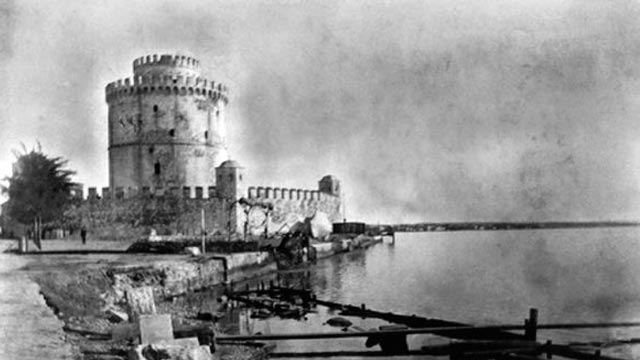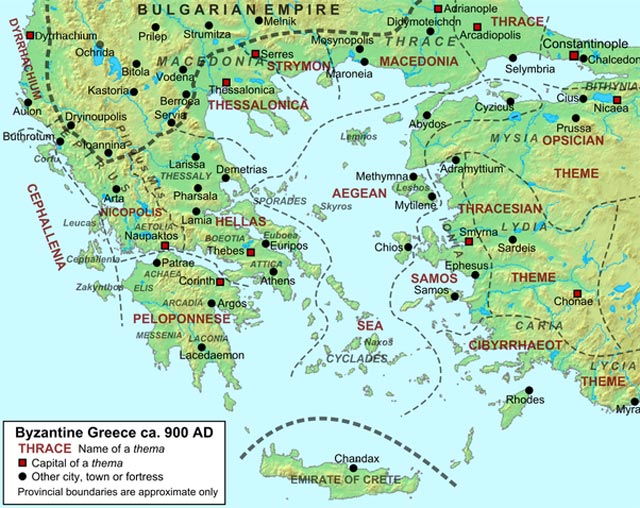There Was More to Byzantium Than Constantinople
 |
| The White Tower in Thessaloniki (Felix J. Koch, 1905). |
Everybody who is familiar with Byzantium knows that its capital, except for a brief period after the Fourth Crusade in 1204, was Constantinople. Constantinople was hand-picked by the Romans as their "second capital," and it was one of the wisest choices they ever made. However, the Empire was more than just one city. In a sense, this is a bit like distinguishing between London and England - while London is of huge international importance, England has a lot more to offer than just one city. Let's look at some other important Byzantine cities besides Constantinople.
The Byzantine Empire lasted for about a thousand years. During that time, areas of importance changed. Think of it in terms of the United States. In 1790, the most important cities could be said to have been Boston and Philadelphia. In 1890, New York and Chicago. In 1990, New York and Los Angeles. Looking at the Byzantine state as a static, unchanging painting is to completely misunderstand it, because different regions within it rose and declined in importance just as quickly and regularly.
As an example, Alexandria in Egypt was a very important city in the early years of the Empire. However, it was lost for good in 645 A.D. during the invasions of the 7th Century and never recovered.
Another example is Ravenna in Italy. It was a hugely important outpost for Emperor Justinian and the Byzantine capital in Italy (Exarchate of Ravenna) from 540-751. In fact, the only surviving image of Justinian made during his life remains to this day in a Ravenna church. However, the Lombards eventually captured Ravenna, and it ceased to play a role in Byzantine life for the next 700 years.
Jerusalem was the center of Byzantine life in the Middle East during the early years of the Empire, through the Fifth Century. However, it became a pawn in the struggles between the empires of the East and West, changing hands numerous times. Its importance as a religious center never diminished despite whoever controlled it at any particular time. The Byzantines were still attempting to control it in the Tenth Century, and one of the goals of requesting aid from the Crusaders was to recover it permanently. That never happened, and eventually, even the Crusaders couldn't hold it. Agreements were made to permit pilgrims to enter the city even after it was lost for good, reflecting its continuing importance for cultural reasons.
Now let's turn to cities with more lasting importance. Nicaea in Bithynia at least arguably was the most important city in the Empire after Constantinople for most of the Empire's history. Nicaea was important in Roman times, being honored by a visit of Emperor Hadrian. For whatever reason, he and other Emperors took a special interest in Nicaea that extended into Byzantine times. Now, we can argue whether that was justified, but it’s very hard to dispute that was the case. During the 7th Century, the Empire reorganized around themes, which are akin to modern counties or parishes.
 |
| Map of the central portion of the Byzantine Empire circa 900 A.D. This was during a temporary surge in power by the Bulgarian Empire that faded not long after. |
The Byzantines placed huge importance on Nicaea. It was the capital of the Opsikian Theme, the very foundation of the Empire during its heyday. It became the center of their resistance after the terrible events of the Fourth Crusade. Its loss to the invaders in 1331 basically signaled the end of effective resistance in Anatolia, though the Byzantines fought valiantly after that (mostly among themselves). Most tellingly, the Patriarchate of Constantinople, exiled from Constantinople, moved there after 1204 when he basically could have gone anywhere else in the Empire. Anyone who knows anything about Byzantium knows that the Patriarch was where the action was. Nicaea faded in importance a bit after the recapture of Constantinople in 1261 but was always considered a vital power center.
Next in importance was Thessaloniki. This was another ancient city that was the capital of the Roman province of Macedonia. It was where Paul the Apostle visited, and all Christians know or should know the importance of the Epistles to the Thessalonians. Again, the Byzantines themselves considered Thessaloniki of immense importance to the empire as a center of trade and power. In its latter stages, Thessaloniki at times became virtually a separate kingdom. There was a long history of Empresses running there when they got upset, closing the gates, and basically telling the Emperor to bugger off. One of the last Byzantine military successes was the recapture of Thessaloniki by Manuel II after some, er, Byzantine negotiations with the Ottomans. Thessaloniki was more important very early in the Empire and toward the end, while Nicaea was of much greater importance in the middle era when the Empire truly flourished.
After those two biggies, it gets a bit murkier, and this is when the time period really does make a difference. Basically, there were several cities of about equal importance after the Big Three of Constantinople, Nicaea, and Thessaloniki. So, let's name a few in no particular order of importance.
After those two biggies, it gets a bit murkier, and this is when the time period really does make a difference. Basically, there were several cities of about equal importance after the Big Three of Constantinople, Nicaea, and Thessaloniki. So, let's name a few in no particular order of importance.
Mistra in the Peloponnese was critical in the last two hundred or so years of the Empire as a base of resistance and nascent resurgence. Before then, though, it was nothing special, just a regional center.
Trebizond was very important as a base of operations for the wars in the East, but it split off and became a separate kingdom around the time of the Fourth Crusade. From a military perspective,
Dyrrachium on the Adriatic was of huge importance because that was where European adventurers always landed and either were beaten or headed along the Via Egnatia to attack Thessaloniki and Constantinople. It was the Byzantine gateway to Western Europe, and it’s unfortunate that its history is largely forgotten.
As mentioned above, Jerusalem was always at the top of Byzantine priorities for religious reasons and the focus of several campaigns (and the initiation of the Crusades), but it was hard to hold for long.
Adrianople (Edirne) was important as a base of operations in the Balkans and was impressive enough for the Ottomans to make it their own capital until they seized Constantinople itself in 1453.
So, the important takeaway is that the Byzantine Empire was more than just Constantinople. It was a web of power centers with Constantinople at its center. Excellent Roman roads connected Byzantine centers together and greatly aided Byzantine armies, just as they had aided Roman armies before them. Nicaea, Thessaloniki, and Dyrrachium were extremely important cities, but there were many others besides them.
2021
 |
| The ruins of Dyrrachium, in Durres, Albania, are not the easiest place in the world to visit. Here are some Byzantine frescos preserved in a chapel in an amphitheater there. |
2021





No comments:
Post a Comment